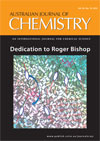
Australian Journal of Chemistry
Volume 65 Number 10 2012
RESEARCH FRONT: Dedication to Roger Bishop
CH12277Roger Bishop's Research Leadership in Crystal Engineering and Supramolecular Chemistry

This introduction outlines Roger Bishop's leadership of research in crystal engineering and supramolecular chemistry, as celebrated at the Crystal Engineering symposium held at the University of New South Wales in November 2011 and in the special papers in this issue.
CH12038Design of Clathrate Compounds that Use Only Weak Intermolecular Attractions
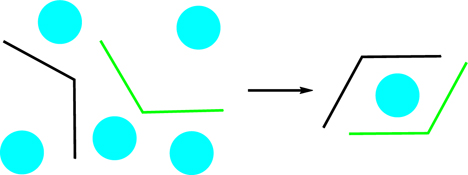
Intermolecular attractive forces that are considerably weaker than hydrogen bonding and coordination complexation may be used in the design of new molecules that function as host molecules in the solid-state. High levels of prediction are possible, and X-ray crystallographic analysis provides a rich source of information about new and previously hidden supramolecular synthons.
CH11501 Metal Template Synthesis of a Tripodal Tris(bipyridyl) Receptor that Encapsulates a Proton and an Iron(II) Centre in a Pseudo Cage
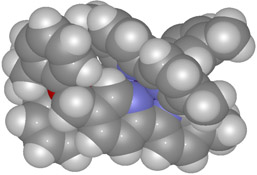
The Fe(ii) template synthesis of a new tripodal tris-bipyridine ligand derivative incorporating a nitrogen bridgehead is reported. The pseudo cage-like structure encapsulates both a proton and an Fe(ii) ion in its cavity and forms an extended helical arrangement ‘capped’ at its open end by a hydrogen bonded PF6– ion.
CH12108Oxidative Dimerisation of Isoflavones: Synthesis of Kudzuisoflavone A and Related Compounds

Kudzuisoflavone-A was successfully synthesised via oxidative dimerisation of daidzein in the presence of cuprous chloride. Appropriately substituted isoflavones also undergo regioselective oxidative dimerisation when treated with thallium trifluoroacetate to give novel 6′,6′″-biisoflavones in good yield. A rationale for the regioselectivity is proposed.
CH12085Highly Sheared Anti-Parallel Dipolar Carbonyl···Carbonyl Interaction in the Crystal Packing of Strapped Crown-3-Pyromellitimide
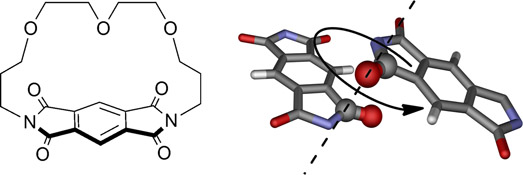
Single crystal X-ray analysis of the strapped crown-3-pyromellitimide above shows unusual highly sheared anti-parallel dipolar carbonyl···carbonyl interaction as evident by the large (44°) torsion angle between the two carbonyl groups. This suggests that the geometric range of the carbonyl···carbonyl interaction is larger than previously thought.
CH12090Facile Synthesis of Triarylmethanimine Promoted by a Lewis Acid–Base Pair: Theoretical and Experimental Studies
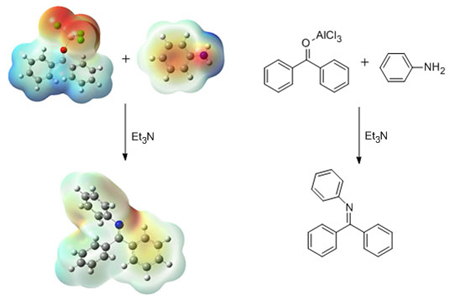
Under the promotion of a Lewis acid–base pair (AlCl3–Et3N), a series of triarylmethanimines were successfully prepared under mild conditions in good to excellent yields with a simple work-up procedure. The method was designed through mechanistic analysis with the aid of density functional theory.
CH12140Synthesis and Pharmacological Evaluation of 4-Iminothiazolidinones for Inhibition of PI3 Kinase
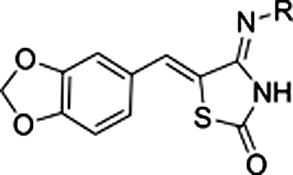
The thiazolidinediones (TZD) have previously shown pan-inhibition of phosphoinositide 3-kinase (PI3K). Our aim was to derivatize the TZD core to introduce selectivity for PI3K isoforms. Synthesis, characterization and inhibition assay studies of 28 4-iminothiazolidin-2-ones are described here. While poorly active for class I PI3K isoforms, this compound class showed inhibitory activity for the phosphodiesterases.
CH12155N-2-Propenyl-(5-dimethylamino)-1-naphthalene Sulfonamide, a Novel Fluorescent Monomer for the Molecularly Imprinted Polymer-Based Detection of 2,4-Dinitrotoluene in the Gas Phase

2,4-dinitrotoluene (DNT)-imprinted polymers were synthesised in three forms (bulk monolith, plasticiser-modified membrane, and poly(acrylonitrile) phase inversed film) using a novel fluorescent monomer, N-2-propenyl-(5-dimethylamino)-1-naphthalene sulfonamide. The rate of fluorescence quenching upon exposure to DNT vapour was found to be 3–5 times faster in the molecularly imprinted polymer relative to the non-imprinted control polymer.
CH12134Synthesis, Acetylcholinesterase and Alkaline Phosphatase Inhibition of Some New 1,2,4-Triazole and 1,3,4-Thiadiazole Derivatives

A new series of 4,5-disubstituted-2,4-dihydro-3H-1,2,4-triazole and 2,5-disubstituted-1,3,4-thiadiazole derivatives has been reported. The synthesized compounds were evaluated for their acetylcholinesterase and alkaline phosphatase inhibitory activities.
CH12219Platinum-Ruthenium Nanoparticles: Active and Selective Catalysts for Hydrogenation of Phenylacetylene
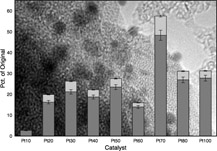
We have synthesised a range of bimetallic ruthenium-platinum colloidal nanoparticles via a simple one-pot method. These particles, immobilised on silica have proven to be active towards the hydrogenation of phenylacetylene to styrene. A synergistic effect between the two metals is observed.
CH12258Trimesic Acid-Based Star Mesogens with Flexible Spacer: Synthesis and Mesophase Characterization
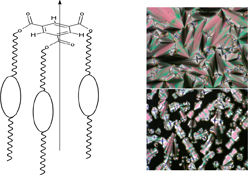
Star mesogens with flexible spacers are exciting molecules for investigation because of the possibilities of numerous conformations adopted by such molecules in mesophases. Herein we report star mesogens based on trimesic acid and discuss their smectic polymorphism, mesophase stability, and tripod shape conformation.
CH12233Two New One-Dimensional Homospin Dy(III) Compounds Showing Slow Magnetic Relaxation
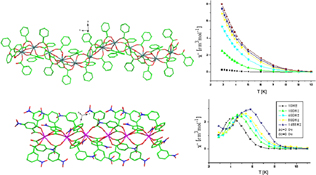
We present here two new 1D Dy(iii) compounds and their magnetic studies. Compound 1 shows a special 1D chain structure composed of three distinct polyhedra, whereas 2 shows an uncommon ion-pair structure. Intra-chain ferromagnetic interactions and slow magnetic relaxation are observed in 1 and 2. An energy barrier as high as 92.5 K was observed in 2.
CH12255One-Pot, Three-Step Reaction of 5-[(Trimethylsilyl)ethynyl]pyrrolidin-2-one with Azides Catalyzed by CuI: Synthesis of a Novel Class of 1,4-Disubstituted 1,2,3-Triazoles

A very fast, easy and efficient synthesis is described for a novel and biologically important class of 1,4-disubstituted-4-(5-pyrrolidin-2-one)-1,2,3-triazoles by an ultrasound-assisted one-pot, three-step click reaction sequence of 5-[(trimethylsilyl)ethynyl]pyrrolidin-2-one with organic azides mediated by catalytic CuI salts.
CH12292Photoproducts of 7-Hydroxycoumarins in Aqueous Solution
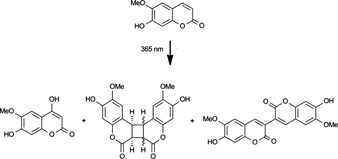
Photolysis of the natural coumarins, 6,7-dihydroxycoumarin (esculetin) and 7-hydroxy-6-methoxycoumarin (scopoletin) in water at 350– 400 nm involved the excited state of the phenolate anion and afforded a monomeric oxidation product and dimers, for which ESI-MS suggested, had the structures shown (for scopoletin). Cyclodimerisation is favoured in organic solvents, while oxidative dimerisation is favoured in aqueous solution.
CH121661,2,3-Triazole Ferrocenyldendrimers Through Click Chemistry Approach and their Optical and Electrochemical Properties
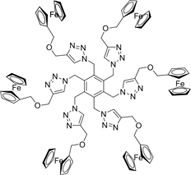
Novel ferrocenyl dendrimers with ferrocene as a surface unit and with triazole as branching point have been synthesised through click chemistry. The presence of more triazole and ferrocenyl units at the antenna increase the light absorbing ability. The electrochemical behaviour changes with increasing ferrocenyl and triazole units.



